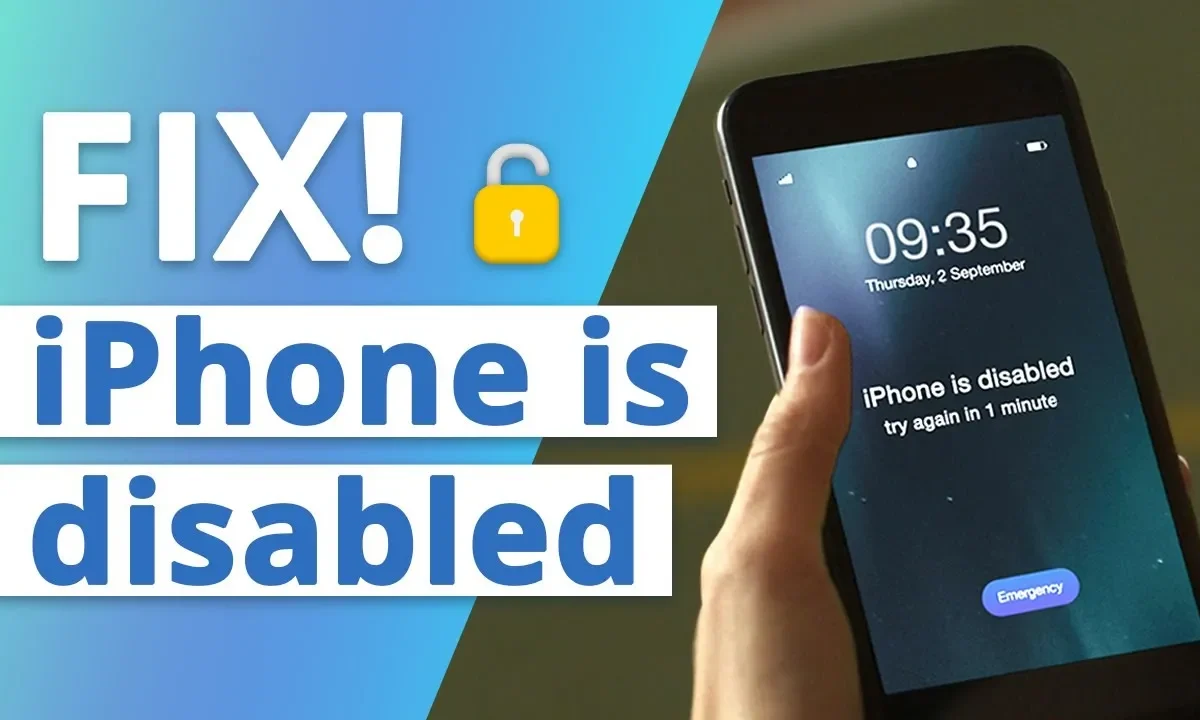When an iPhone is disabled, it means that the device has been locked due to the user entering the wrong passcode multiple times. When this happens, the iPhone will display a message on the screen stating that the device is disabled, and the user will be prompted to connect the device to iTunes in order to restore it. The problem with this is that the user may not have access to a computer with iTunes or may not want to go through the process of restoring the device using iTunes. Therefore, finding a solution to fix the disabled iPhone without going through iTunes is important for those who want to avoid the inconvenience of using iTunes or those who do not have access to a computer with iTunes installed.
Finding a solution to fix a disabled iPhone without using iTunes is important for a number of reasons:
- Convenience: Not everyone has access to a computer with iTunes installed, and even if they do, it may not be convenient to use it to restore their device. Finding a solution that does not require iTunes can be more convenient and save time.
- Accessibility: Some users may not be tech-savvy or may not have the technical knowledge required to use iTunes to restore their device. Finding a solution that is easy to use and does not require technical skills can make the process of fixing a disabled iPhone more accessible to a wider range of users.
- Data Loss: Restoring an iPhone using iTunes can result in the loss of all data on the device. By finding a solution that does not involve iTunes, users can avoid the risk of losing their important data.
- Cost: Using a third-party software like Tenorshare 4uKey to fix a disabled iPhone can be more cost-effective than taking the device to a professional repair shop.
Also read: How To Delete Instagram Account Permanently/Temporarily (Android, IPhone, Web)
Overall, finding a solution to fix a disabled iPhone without using iTunes can be more convenient, accessible, and cost-effective for users who want to avoid the hassle of using iTunes or who do not have access to a computer with iTunes installed.
Reasons why an iPhone gets disabled
Entering the wrong passcode multiple times
Entering the wrong passcode multiple times is one of the main reasons why an iPhone may become disabled. When a user enters the wrong passcode multiple times, the iPhone will lock itself and display a message stating that the device is disabled. This is a security feature designed to prevent unauthorized access to the device and protect the user’s data.
By default, after six unsuccessful attempts to enter the passcode, the iPhone will become disabled for a period of time, usually one minute. If the user continues to enter the wrong passcode, the time period of the disabled state will increase with each attempt until the device becomes permanently disabled.
If an iPhone becomes disabled due to entering the wrong passcode multiple times, the user can usually fix the problem by restoring the device using iTunes or another method. However, this can result in the loss of all data on the device, which is why it is important to take measures to prevent the problem from occurring in the first place.
Software malfunction
Another reason why an iPhone may become disabled is due to a software malfunction. This can happen if there is a bug or glitch in the iOS operating system or if there is an issue with a specific app or process running on the device.
In some cases, a software malfunction can cause the iPhone to become stuck in a loop or freeze up, making it unresponsive to touch or other inputs. This can result in the device becoming disabled and displaying an error message on the screen.
If an iPhone becomes disabled due to a software malfunction, there are several methods that can be used to fix the problem without resorting to restoring the device using iTunes. These methods may include performing a hard reset or using a third-party software tool like Tenorshare ReiBoot to repair the operating system.
It is important to keep the iOS operating system and all apps up-to-date in order to minimize the risk of a software malfunction. Regularly checking for software updates and installing them as soon as they become available can help prevent issues and ensure that the device runs smoothly.
Hardware issues
While less common than other causes, hardware issues can also lead to an iPhone becoming disabled. These issues can include a malfunctioning or damaged home button, a faulty charging port, or a damaged display.
If one of these hardware components fails, it can cause the iPhone to become unresponsive or display error messages that can result in the device becoming disabled. In some cases, a hardware issue may require professional repair or replacement of the affected component.
If an iPhone becomes disabled due to a hardware issue, the user may be able to fix the problem by troubleshooting the issue or replacing the affected component. However, this can be more challenging than fixing a software or passcode issue and may require more technical expertise or the help of a professional repair service.
To minimize the risk of hardware issues, it is important to handle the device carefully and protect it from damage. Using a protective case, avoiding exposure to extreme temperatures or moisture, and being careful when plugging in charging cables or headphones can all help prevent hardware issues from occurring.
How to fix an iPhone that is disabled without using iTunes
Method 1: Using iCloud to erase and restore the device
One method to fix a disabled iPhone without using iTunes is to use iCloud to erase and restore the device. This method requires that the user has previously enabled the Find My feature on their iPhone and has access to a web browser on a computer or another mobile device.
Step-by-step guide on how to use iCloud to restore your device:
- On a computer or another mobile device, open a web browser and go to icloud.com/find.
- Sign in to your iCloud account using your Apple ID and password.
- Click on the Find My iPhone icon.
- From the list of devices, select the disabled iPhone.
- Click on the Erase iPhone button.
- Follow the prompts to confirm the erasure of the device.
- Once the device has been erased, follow the on-screen prompts to set up the device as new or restore it from a previous backup.
Note that this method will erase all data on the device, including contacts, messages, and media files. However, if the user has previously backed up the device to iCloud or another location, they can restore the data after the device has been erased and set up as new.
This method can be useful for users who have previously enabled the Find My feature and have access to a web browser, but it may not be suitable for users who do not have access to a computer or who have not enabled Find My on their iPhone.
You should know: Difference between GBWhatsApp and WhatsApp: Which One Should You Use?
Method 2: Using a third-party software like Tenorshare 4uKey
Another method to fix a disabled iPhone without using iTunes is to use a third-party software tool like Tenorshare 4uKey. This software is designed to help users unlock and fix a disabled iPhone without the need for iTunes or any other complex technical procedures.
Step-by-step guide on how to use Tenorshare 4uKey to fix a disabled iPhone:
- Download and install Tenorshare 4uKey on your computer.
- Launch the program and connect your disabled iPhone to the computer using a USB cable.
- Click on the Start button to begin the process.
- Follow the on-screen prompts to put your iPhone into recovery mode or DFU mode.
- Once your iPhone is in recovery or DFU mode, the program will automatically download the latest firmware for your device.
- Click on the Download button to begin the firmware download.
- After the firmware has been downloaded, click on the Unlock Now button to unlock your disabled iPhone.
- Follow the on-screen prompts to complete the process.
Note that this method will erase all data on the device, including contacts, messages, and media files. However, if the user has previously backed up the device to iCloud or another location, they can restore the data after the device has been unlocked and set up as new.
Tenorshare 4uKey is a paid software, but it offers a free trial version that allows users to test the software before purchasing it. It is compatible with both Windows and Mac computers and supports a wide range of iOS devices, including the latest models.
Method 3: Using Recovery Mode
Another method to fix a disabled iPhone without using iTunes is to use Recovery Mode. Recovery Mode is a built-in feature of iOS devices that allows users to restore the device to its original factory settings and fix various issues, including a disabled iPhone.
Step-by-step guide on how to put your iPhone into Recovery Mode
Here is a step-by-step guide on how to put your iPhone into Recovery Mode:
- Connect your iPhone to your computer using a USB cable.
- Press and quickly release the Volume Up button.
- Press and quickly release the Volume Down button.
- Press and hold the Side button until the recovery mode screen appears. Keep holding the Side button until you see the screen with the option to restore or update your iPhone.
Note: If your iPhone is not responding, or the screen is black, you may need to force restart your device by following these steps: press and quickly release the Volume Up button, press and quickly release the Volume Down button, then press and hold the Side button until the Apple logo appears.
- In iTunes, click on the Restore button to restore your iPhone to its original factory settings.
- Follow the on-screen prompts to complete the process.
Note that putting your iPhone into Recovery Mode will erase all data on the device, including contacts, messages, and media files. However, if the user has previously backed up the device to iCloud or another location, they can restore the data after the device has been restored and set up as new.
It is important to ensure that the latest version of iTunes is installed on the computer before attempting to put your iPhone into Recovery Mode. Additionally, this method should only be used as a last resort when other methods, such as using iCloud or third-party software, have not worked to fix a disabled iPhone.
Step-by-step guide on how to restore your device using Recovery Mode
Here is a step-by-step guide on how to restore your iPhone using Recovery Mode:
- Connect your iPhone to your computer using a USB cable.
- Open iTunes on your computer. If you don’t have iTunes installed, you can download it from the Apple website.
- Press and quickly release the Volume Up button.
- Press and quickly release the Volume Down button.
- Press and hold the Side button until the recovery mode screen appears. Keep holding the Side button until you see the screen with the option to restore or update your iPhone.
- Click on the Restore button in iTunes. This will erase all data and settings from your iPhone and install the latest version of iOS.
- Follow the on-screen prompts to complete the restore process. This may take several minutes to complete.
- Once the restore process is complete, set up your iPhone as new or restore from a backup.
Note that restoring your iPhone using Recovery Mode will erase all data and settings from your device. If you have a backup of your device, you can restore your data and settings after the restore process is complete.
It is important to ensure that the latest version of iTunes is installed on the computer before attempting to restore your iPhone using Recovery Mode. Additionally, this method should only be used as a last resort when other methods, such as using iCloud or third-party software, have not worked to fix a disabled iPhone.
Tips to avoid getting your iPhone disabled
Here are some tips to help you avoid getting your iPhone disabled:
- Use a strong passcode: Use a strong passcode that is difficult for others to guess, such as a combination of letters, numbers, and symbols.
- Don’t share your passcode: Avoid sharing your passcode with others, even if they are family or friends.
- Use Touch ID or Face ID: If your iPhone has Touch ID or Face ID, consider using it to unlock your device instead of a passcode.
- Enable Erase Data: Enable the Erase Data feature on your iPhone, which will erase all data on the device after 10 failed passcode attempts.
- Keep your iPhone updated: Keep your iPhone updated with the latest software updates, which can help to fix security vulnerabilities.
- Enable Find My: Enable the Find My feature on your iPhone, which can help you locate your device if it is lost or stolen.
- Use a password manager: Consider using a password manager to store your passcodes and other sensitive information securely.
By following these tips, you can help to protect your iPhone from being disabled and keep your personal information secure.
Conclusion
Getting your iPhone disabled can be a frustrating experience, but there are several methods to fix the problem without using iTunes. These methods include using iCloud to erase and restore the device, using third-party software like Tenorshare 4uKey, and using Recovery Mode to restore the device. It’s important to keep in mind that putting your iPhone into Recovery Mode will erase all data and settings from the device, so it’s always a good idea to have a backup of your data before attempting any fixes. Additionally, taking preventive measures like using a strong passcode, enabling Find My, and keeping your iPhone updated can help to avoid getting your iPhone disabled in the first place.





